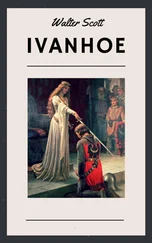Stanza XVI. line 300. ‘Although we do not learn that Cuthbert was, during his life, such an artificer as Dunstan, his brother in sanctity, yet, since his death, he has acquired the reputation of forging those Entrochi which are found among the rocks of Holy Island, and pass there by the name of St. Cuthbert’s Beads. While at this task, he is supposed to sit during the night upon a certain rock, and use another as his anvil. This story was perhaps credited in former days; at least the Saint’s legend contains some not more probable.’-SCOTT.
See in Mr. Aubrey de Vere’s ‘Legends of the Saxon Saints’ a fine poem entitled ‘How Saint Cuthbert kept his Pentecost at Carlisle.’ The ‘beads’ are there referred to thus:-
‘And many an age, when slept that Saint in death,
Passing his isle by night the sailor heard
Saint Cuthbert’s hammer clinking on the rock.’
The recognised name of these shells is still ‘St. Cuthbert’s beads.”
Stanza XVII. line 316. ‘Ceolwolf, or Colwulf, King of Northumberland, flourished in the eighth century. He was a man of some learning; for the venerable Bede dedicates to him his “Ecclesiastical History.” He abdicated the throne about 738, and retired to Holy Island, where he died in the odour of sanctity. Saint as Colwulf was, however, I fear the foundation of the penance-vault does not correspond with his character; for it is recorded among his memorabilia, that, finding the air of the island raw and cold, he indulged the monks, whose rule had hitherto confined them to milk or water, with the comfortable privilege of using wine or ale. If any rigid antiquary insists on this objection, he is welcome to suppose the penance-vault was intended by the founder for the more genial purposes of a cellar.
‘These penitential vaults were the Geissel-gewolbe of German convents. In the earlier and more rigid times of monastic discipline, they were sometimes used as a cemetery for the lay benefactor of the convent, whose unsanctified corpses were then seldom permitted to pollute the choir. They also served as places of meeting for the chapter, when measures of uncommon severity were to be adopted. But their most frequent use, as implied by the name, was as places for performing penances, or undergoing punishment.’-SCOTT.
Stanza XVIII. line 350. ‘Antique chandelier.’-SCOTT.
Stanza XIX. line 371. ‘That there was an ancient priory at Tynemouth is certain. Its ruins are situated on a high rocky point; and, doubtless, many a vow was made to the shrine by the distressed mariners, who drove towards the iron-bound coast of Northumberland in stormy weather. It was anciently a nunnery; for Virca, abbess of Tynemouth, presented St. Cuthbert (yet alive) with a rare winding-sheet, in emulation of a holy lady called Tuda, who had sent him a coffin: but, as in the case of Whitby, and of Holy Island, the introduction of nuns at Tynemouth, in the reign of Henry VIII, is an anachronism. The nunnery of Holy Island is altogether fictitious. Indeed, St. Cuthbert was unlikely to permit such an establishment; for, notwithstanding his accepting the mortuary gifts above mentioned, and his carrying on a visiting acquaintance with the abbess of Coldingham, he certainly hated the whole female sex; and, in revenge of a slippery trick played to him by an Irish princess, he, after death, inflicted severe penances on such as presumed to approach within a certain distance of his shrine.’-SCOTT.
line 376. ruth(A. S. hreow , pity) in Early and Middle English was used both for ‘disaster’ and ‘pity.’ These two shades of meaning are illustrated by Spenser in F. Q., Bk. ii. I. Introd. to Canto where Falsehood beguiles the Red Cross Knight, and ‘workes him woefull ruth,’ and in F. Q. I. v. 9:
‘Great ruth in all the gazers hearts did grow.’
Milton (Lycidas, 163) favours the poetical employment of the word, which modern poets continue to use. Cp. Wordsworth, ‘Ode for a General Thanksgiving’:-
‘Assaulting without ruth
The citadels of truth;’
and Tennyson’s ‘Geraint and Enid,’ II. 102:-
‘ Ruth began to work
Against his anger in him, while he watch’d
The being he lov’d best in all the world.’
Stanza XX. line 385. doublet, a close-fitting jacket, introduced from France in the fourteenth century, and fashionable in all ranks till the time of Charles II. Cp. As You Like It, ii. 4. 6:-’Doublet and hose ought to show itself courageous to petticoat.’
line 398. Fontevraud, on the Loire, 8 miles from Saumur, had one of the richest abbeys in France. It was a retreat for penitents of both sexes, and presided over by an abbess. ‘The old monastic buildings and courtyards, surrounded by walls, and covering from 40 to 50 acres, now form one of the larger prisons of France, in which about 2000 men and boys are confined, and kept at industrial occupations.’ See Chambers’s ‘Encyclopaedia,’ s. v., and Chambers’s Edinburgh Journal , 2d. S, I. 104.
Stanza XXI. line 408. but= except that. Cp. Tempest, i. 2. 414:-
‘And, but he’s something stain’d
With grief that’s beauty’s canker, thou might’st call him
A goodly person.’
line 414. Byron, writing to Murray on 3 Feb., 1816, expresses his belief that he has unwittingly imitated this passage in ‘Parisina.’ ‘I had,’ he says, ‘completed the story on the passage from Gibbon, which indeed leads to a like scene naturally, without a thought of the kind; but it comes upon me not very comfortably.’ Byron is quite right in his assertion that, if he had taken this striking description of Constance as a model for his Parisina, he would have been attempting ‘to imitate that which is inimitable.’ See ‘Parisina,’ st. xiv:-
‘She stood, I said, all pale and still,
The living cause of Hugo’s ill.’
Stanza XXII. line 415. a sordid soul, &c. For such a character in the drama see Lightborn in Marlowe’s Edward II, and those trusty agents in Richard III, whose avowed hardness of heart drew from Gloucester the appreciative remark:-
‘Your eyes drop millstones, when fools’ eyes drop tears.’
Richard III, i. 3. 353.
Stanza XXIII. line 438. grisly, grim, horrible; still an effective poetic word. It is, e.g., very expressive in Tennyson’s ‘Princess,’ sect. vi, where Ida sees
‘The haggard father’s face and reverend beard
Of grisly twine, all dabbled with the blood,’ &c.
See below, III. 382.
Stanza XXV. line 468. ‘It is well known, that the religious, who broke their vows of chastity, were subjected to the same penalty as the Roman vestals in a similar case. A small niche, sufficient to enclose their bodies, was made in the massive wall of the convent; a slender pittance of food and water was deposited in it, and the awful words, VADE IN PACE, were the signal for immuring the criminal. It is not likely that, in latter times, this punishment was often resorted to; but among the ruins of the abbey of Coldingham, were some years ago discovered the remains of a female skeleton, which, from the shape of the niche, and position of the figure, seemed to be that of an immured nun.’-SCOTT.
Lockhart adds:-‘The Edinburgh Reviewer, on st. xxxii, post , suggests that the proper reading of the sentence is vade in pacem -not part in peace , but go into peace , or eternal rest, a pretty intelligible mittimus to another world.’
Читать дальше






